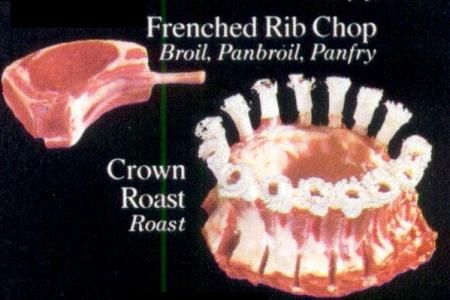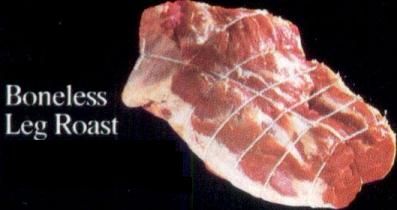
Since the church began commemorating Christ's sacrifice with the annual observance of Easter European Christians have been eating lamb as part of the Easter tradition. This being the case, one's forced to wonder if the eating of lamb is symbolic of the death, and resurrection of Christ?
As it turns out, most fervent Christians acknowledge a link between the Lamb of God and the lamb on their Easter plate. In fact, in the 9th century whole roasted lamb became the nucleus of the Pope's Easter Dinner, and has been so ever since.
I've never done lamb before, but I've been a bit more "church-minded" for the last year or so. Thus, my family and I decided to throw caution to the wind and experiment with a rack of lamb this year. I initiated my customary first step, by scouring the internet for the perfect recipe. After much research, I finally settled on a Crown Roast of Lamb Recipe by Alton Brown, mostly because I like the sound of the herbs, spices, and other flavoring his recipe uses, plus his directions for frenching the racks were pretty clear.
-
Crown Roast of Lamb Recipe by Alton Brown
Ingredients
2 racks lamb, 6 to 8 ribs each, approximately 1 1/2 to 2-pounds each
1 tablespoon olive oil
1 teaspoon kosher salt
1/2 teaspoon freshly ground black pepper
6 cloves garlic, minced
4 teaspoons fresh thyme, chopped
1 1/2 teaspoons ground coriander
1 to 1 1/2 tablespoons sherry vinegar
1/2 to 1 teaspoon Dijon mustard
1/2 to 1 teaspoon chopped fresh rosemary leaves
Directions
Preheat the oven to 375 degrees F.
To french the racks of lamb:
Make a cut on the fat side of the ribs, perpendicular to them, about 2 1/2-inches down from the rib ends. Cut through the fat down to the rib bones.
Turn the rack on end, with the bones facing up and push a knife through the flesh between each rib, using the initial cut as a guide for the knife. Cut down the side of each rib to remove the excess fat in between each rib. Using strong kitchen twine, wrap the twine around each rib at the base, nearest the meat and pull to remove all of the remaining fat and sinew from the rib bone.
Bend each rack into a semicircle (meat side in and fat side out) and using kitchen twine tie them together at the base and center, in order to hold the racks together. The rib ends should be pushed outward to create the look of a crown.
To season & cook the lamb:
Rub the lamb with the olive oil. Combine the salt, pepper, garlic, thyme and coriander and press all over the lamb. Place the roast in a Bundt pan with the center of the pan coming up through the middle of the roast.
Place on the middle rack of the oven and cook for 30 to 35 minutes, until the meat reaches an internal temperature of 130 degrees F. This is approximately 8 to 12 minutes per pound. Remove from the oven, transfer the roast to a rack, cover with aluminum foil and let the meat rest for 20 minutes. While the meat is resting add the sherry vinegar, mustard and rosemary to the juices that accumulated in the Bundt pan while cooking. Stir to combine. Taste and adjust seasoning, as needed. Cut the string away from the roast and place cooked stuffing, rice or barley in the center if desired. Serve the warm sauce with the roast.
-
We hit a slights snag. Most of our local grocers don't sell lamb. Costco fortunately does. We visited Costco the Monday before Easter, and the racks of lamb had already been thoroughly picked over.
Lamb chops are small to begin with, taking 2 to 3 chops to constitute a main course. I was looking at racks of 8 to 10 one bite chops for over $10 a pound. Roughly $7.50 out of every $10 would have been paying for bone, rather than meat. Seriously, these racks looked like multi-packs of meat flavored lollipops, 4 of which MIGHT have constituted a decent sized appetizer.
Fortunately, the same freezer case held boneless leg of lamb roasts for a little over $5 per pound. I thought for a moment.
With these three things in mind, and figuring half a pound of meat per person, I left with a five pound roast.
The roast was a little more than half the price of the racks.
Some fat & sinew would need to be cut away, but with no bone to speak of, the price would mostly be covering meat.
Since they're both lamb, I should be able to use roughly the same herbs, spices, and seasonings that I would've used on the racks.
Not being able to find a single recipe that caught my fancy, I put together the following amalgam based on a number of recipes and government cooking guidelines. Then I chose two Oregon Pinot Noirs (**NV Rascal & 2011 Eola Hills) to accompany the meal.
Next week: Come back for Part 2 to learn how the roast turned out. Did my research pay off & produce a quality recipe? Did the wines compliment or overpower the meal? Find out.
Recipes print individually as pages 2 & 4 for your refrigerator or recipe file.
**NV = Non Vintage (denotes a wine that is a blend of grapes from different years as well as different vineyards and/or varietals)
-
 Roasted Boneless Leg of Lamb
Roasted Boneless Leg of LambIngredients
2 lemons
5 garlic cloves, minced
1/3 cup finely chopped fresh Italian parsley
Kosher salt
Freshly ground black pepper
2 tablespoons olive oil, plus more for coating the meat
1 (4 to 5pound) boneless leg of lamb, netting removed
Butcher’s twine
Directions
Heat the oven to 400°F and arrange a rack in the middle.
Finely grate the zest from the lemons. (If you’re using a vegetable peeler, finely chop the peeled zest.) Place the lemon zest, garlic, parsley, and measured oil in a medium bowl and season with salt and pepper. Stir until an evenly combined paste forms; set aside.
Unroll the lamb, lay it flat on a cutting board, and remove any large pieces of gristle, sinew, or fat. Season the top surface of the lamb generously with salt and pepper, then, using your hands, spread the lemon-garlic-parsley paste over the seasoned meat. Roll the lamb back up, so the seasoning paste is inside the roast, and tie it in several places, about 1 to 2 inches apart, with butcher’s twine. Rub some; olive oil, salt, and pepper; all over the outside of the lamb and place it in a roasting pan.
Insert an oven-safe meat thermometer into the thickest part of the boneless leg of lamb. Set the lamb into the 450º F (230º C) oven and roast for 20 minutes. After the 20 minutes, lower the temperature to 325º F (165º C) and continue cooking the lamb until the internal temperature is to your liking (See chart below). Transfer the lamb to a cutting board and let it rest for 10 to 15 minutes. Remove the twine, carve, and serve.
(Source: United State Department of Agriculture)
Oven Temp = 325° F (165º C) After Being At 450º F (230º C) For 20 minutes
| DESIRED DONESS LEVEL | APPROXIMATE Roasting Time | Internal Temperature To Be Reached |
| Rare | 20 to 25 minutes per pound | 135 F (57.2 C) |
| Medium-rare | 25 to 30 minutes per pound | 145 F (62.8 C) |
| Medium (to medium well) | 30 to 3 minutes per pound | 160 F (72.0 C) |
| Well done* | 35 to 40 minutes per pound | 170 F (77.0 C.) |
There are several factors that will affect the cooking time:
- The shape of the roast
- The internal temperature when you first put it in the oven
- Bone-in roast will require extra cooking time
- Fluctuations in temperature of your own oven.
Meat pictures courtesy of The National Live Stock & Meat Board

No comments:
Post a Comment